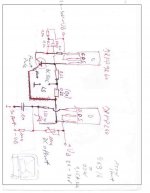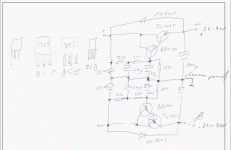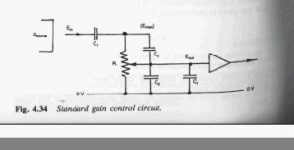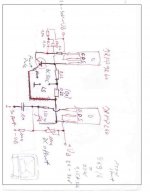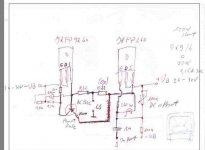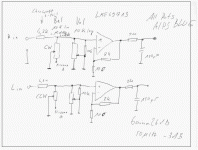I promised to publish my Power Buffer, so here it is. It is super simple so i did not even make a circuit diagram. What you get is my building instruction. I will tell you more how it works soon. It sound very good, absolutely grain free, and you can make it from unexpensive, easy to get parts. It has very little PSU rejection so with a conventional PSU it will hum. I do not like regulated supplies much because of the transient response. One good solution is the darlington cap multiplier shown. It has no voltage gain so you need a preamp that can put out around 10V. The easiest solution is a good CFA like the LME49713. It sounds really brilliant and is hard to beat with a discrete circuit. It is also the main building block of my super high speed preamp. That preamp biases the LME49713 into class a and has a BUF634 buffer. Actually i whould not build it that way any more. I think the LME alone is even better. The sofistication was in the volume and balance control. A normal pot, even a good one is nearly useless over 500kHz because of the stray capacitances so i made it different, also the balance control that can be the origin of crosstalk in the higher reaches. See the simple picture of stray capacitances in potmeters from one of JLH books. Unfotunately i lost the schematic but i will back engineer the unit in the next day so you get a high speed preamp schematic.
Attachments
OK, that is the reson !
The buffer works the following way :
The signal goes to the gate of the IRPF240, then it goes out from the source to the speaker.
A common base stage senses that signal and puts it to the gate of the IRPF9240.
There is another loop. The signal from the source of the IRPF9240 is also sensed by the base of the bipolar. That signal is also amplified into the gate of the IRPF9420 and is buffered to the source of the IRF40.
Is that error feedback, feedforward or what ? I do not know, but it works.
I run my sample on too much voltage ( around 35V plus-minus ) so it gets very hot.
I simply do not have the correct transformer. One solution is to use a second pair of Fets and half the iddle current.
The buffer works the following way :
The signal goes to the gate of the IRPF240, then it goes out from the source to the speaker.
A common base stage senses that signal and puts it to the gate of the IRPF9240.
There is another loop. The signal from the source of the IRPF9240 is also sensed by the base of the bipolar. That signal is also amplified into the gate of the IRPF9420 and is buffered to the source of the IRF40.
Is that error feedback, feedforward or what ? I do not know, but it works.
I run my sample on too much voltage ( around 35V plus-minus ) so it gets very hot.
I simply do not have the correct transformer. One solution is to use a second pair of Fets and half the iddle current.
Last try....
I do like the common base application.
Here is the High Speed Preamp 2012.
Again it is pathological simple but hard to beat. PSU can be the ATL Mini Shunts.
-3dB is at 50MHz due to the fact that bandwidth in a CFA is not much affected by gain but by the value of the feedback resistor, in this case 2KOhm. When you run into oszillation ( that should not happen because the LME49713 is specified down to 1,2kOhm ) you can increase it to 3,5kOhm. Then we get 25MHz -3dB.
The trick is in the volume and balance control. It is shunt and so not directly in the signal path so we do not run into trouble with parasitics. The Alps blue works brilliant here. Connected conventional i prefer the TKD but here it works brilliant.
Gain is setup to drive the power buffer. It can be reduced by changing the low value feedback resistor. A combination of 2KOhm plus 2kOhm gives you 6dB for example.
The shunt volume has 3 disadvantages. One is a slight loss in gain and the other is the rather low input impedance that should not be a problem with modern sources. Third the 4,2kOhm resitor gives some noise but S/N should still be in the -100dB class. I used a Charcroft Z-Foil here. Today i would use a Dale RS65. It is less expensive and as good.
Again it is pathological simple but hard to beat. PSU can be the ATL Mini Shunts.
-3dB is at 50MHz due to the fact that bandwidth in a CFA is not much affected by gain but by the value of the feedback resistor, in this case 2KOhm. When you run into oszillation ( that should not happen because the LME49713 is specified down to 1,2kOhm ) you can increase it to 3,5kOhm. Then we get 25MHz -3dB.
The trick is in the volume and balance control. It is shunt and so not directly in the signal path so we do not run into trouble with parasitics. The Alps blue works brilliant here. Connected conventional i prefer the TKD but here it works brilliant.
Gain is setup to drive the power buffer. It can be reduced by changing the low value feedback resistor. A combination of 2KOhm plus 2kOhm gives you 6dB for example.
The shunt volume has 3 disadvantages. One is a slight loss in gain and the other is the rather low input impedance that should not be a problem with modern sources. Third the 4,2kOhm resitor gives some noise but S/N should still be in the -100dB class. I used a Charcroft Z-Foil here. Today i would use a Dale RS65. It is less expensive and as good.
Attachments
At the output there is a 1,5MHz low pass for the power buffer.
When you use it as a conventional preamp you can reduce the resistor to 10 Ohm.
You can also use a 50 Ohm or 75 Ohm and terminate the other side also with 50 or 75 Ohm. Then you have a very robust transmission line provided you use the correct impedance cable and BNC jacks.
That i would do in the lab. You loose 6dB of gain though.
When you use it as a conventional preamp you can reduce the resistor to 10 Ohm.
You can also use a 50 Ohm or 75 Ohm and terminate the other side also with 50 or 75 Ohm. Then you have a very robust transmission line provided you use the correct impedance cable and BNC jacks.
That i would do in the lab. You loose 6dB of gain though.
Last try....
Looks like your inventing the Nelson Pass Current Source a second time.
Reinhard
OK, i liked the Aleph, better then the new ones. I heard it in 1993 with my Medea at Reinhard Wendemuth. It had tremendoes speed. I think the new Pass amps are more optimised for conventional speakers that can sound a little sharp.
The only problem with early Aleph was that they where easy to blow.
What do you think about the Sauermann amp ?
A double Aleph ?
The only problem with early Aleph was that they where easy to blow.
What do you think about the Sauermann amp ?
A double Aleph ?
What do you think about the Sauermann amp ?
A double Aleph ?
Have heard it one time here in Lemgo at a meeting at the "old Offizierskasino"
with Dieter F. and Georg S. It was not in the main setup. But it was good, I like Class A.
It is not an Aleph. As I understand it is a differential "Ring Of Two". Sadly I had not the time to discuss the design with Gerd.
Regards Reinhard
